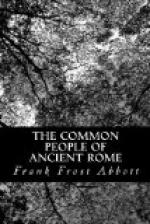Before trying to connect the Satirae with a serious romance of the type just mentioned, let us follow another line of descent which leads us to the same objective point, viz., the appearance of the serious story in prose. We have been led to consider the possible connection of this kind of prose fiction with the epic by the presence in both of them of the love element and that of adventure. But the Greek novel has another rather marked feature. It is rhetorical, and this quality has suggested that it may have come, not from the epic, but from the rhetorical exercise. Support has been given to this theory within recent years by the discovery in Egypt of two fragments of the Ninos romance. The first of these fragments reveals Ninos, the hero, pleading with his aunt Derkeia, the mother of his sweetheart, for permission to marry his cousin. All the arguments in support of his plea and against it are put forward and balanced one against the other in a very systematic way. He wins over Derkeia. Later in the same fragment the girl pleads in a somewhat similar fashion with Thambe, the mother of Ninos. The second fragment is mainly concerned with the campaigns of Ninos. Here we have the two lovers, probably separated by the departure of Ninos for the wars, while the hero, at least, is exposed to the danger of the campaign.
The point was made after the text of this find had been published that the large part taken in the tale by the carefully balanced arguments indicated that the story grew out of exercises in argumentation in the rhetorical schools.[83] The elder Seneca has preserved for us in his Controversiae specimens of the themes which were set for students in these schools. The student was asked to imagine himself in a supposed dilemma and then to discuss the considerations which would lead him to adopt the one or the other line of conduct. Some of these situations suggest excellent dramatic possibilities, conditions of life, for instance,




